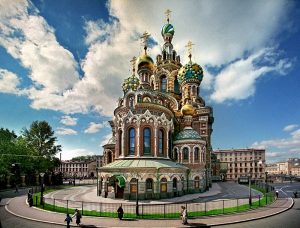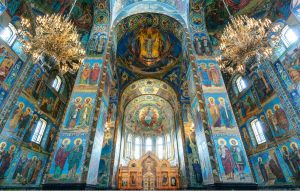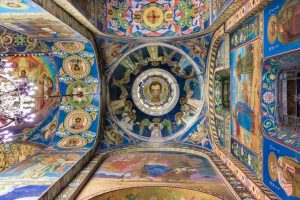The Faith of the Blue Rose is the competing mainline faith in Reims. It is centered about Le Roi David, the King of Reims.
The symbol is a 5 petaled dark blue Tudor Rose with a golden Fleur de Lys laid over it.
Most of the churches and chapels are in a more Russian Orthodox style though not so fancily painted on the outside. Inside almost every inch of every wall and ceiling is overlaid with rich mosaics and bright paintings, bringing the people, places, and the stories of the catechism to life in lavish often larger than life illustrations. The windows as well, fine stained glass also depicting the same.
Inside there is a grand front walling off the Holy of Holies where a lot of the relics and riches of the church are kept. As well as special items used at various times for different holiday and special services. On the most special occasions the doors are opened and just inside the door the highest altar is visible for the most important of the masses and services held.
The basic floorplan is the usual cross, but near the door are two small chapels used for special things (such as the recent respect paid to the services held for the Prince of Amber, Benedict, for his two fallen sons)

The Exterior of the Cathedral of the Faith of The Blue Rose, Paris, Reims. The churches are aligned East to West, with the grand entrance facing East. This Cathedral is fancier and more colorfully painted than the usual for a church of this type. The building seen to the right and behind holds the clerical offices, common rooms, class rooms and other things needed to serve the congregation of this Cathedral and others throughout Reims. To the left is visible the dormitories, dining hall, and classrooms for instruction for the priests and priestesses of the faith and in some cases, their families as well. A full campus stretches out behind both buildings.
This was erected in part of Paris that was devastated during the Great Bombardment (otherwise known as the Rain of Rocks from Hades) that occurred when Le Roi became infuriated over the sheltering and aid given to the Society of the Righteous and their ilk during the Dark Times just as Le Roi David ascended His Throne in Reims. The Traitors also staged a coup which brought down the wrath of Le Roi, and the lesson was learned. One strip of the devastation was rebuilt into the Cathedral complex.

Interior of the Cathedral, looking from East to West from the Great Doors. There are no pews, the faithful stand, knee, or sit on cushions provided as they enter, at the door. It depends on what sort of service. The feeble, elderly, very young, or disabled, are allowed to sit on cushions up at the front during every service. If standing the Cathedral can hold approximately 1000 at once, 1200 if they really crowd. The gold at bottom center is the Curtain Wall to close off the Holy of Holies to most everyone. A few steps lead up to it, and usually a small altar table is placed in front of the door a little ways out for the service or ceremony.
If Le Roi is in presence, He will take shelter in the Holy of Holies and step out as He chooses. On a rare occasion Le Roi will lead the service or ceremony as He so chooses. Le Roi is also well known for very impromptu services and ceremonies as He so chooses to hold. (The Catechism be trampled and trod on as He sees fit at the time, and He does it often, very very often.)

To one side of the central area beyond one of the huge chandeliers, a look up at some of the artwork. The other side is not dissimilar. This is to the right of the picture above. It is believed that is a picture of a just adult lad version of Le Roi David. The one to the left depicts a woman who is believed to be either Marlena Sawall, His Royal Majesty’s mother, or his wife, Her Majesty Queen Michelle. Scholars are still debating which one is immortalized.
The only place in the entire church where others of the Royal Family, most of the Quaddity figures, can be seen in the left small chapel near the door. In figures about a foot high. There are quite a number of them, seemingly a number of wives, mistresses and concubines of the God Creator Corwin, and a number of his offspring. Like a big class reunion that never came to be, the figures are ranked in rows and groups doing small things (like one figure holds up a shining purple teardrop on a thin chain to admire it and several others are grouped around also looking at it, etc). In the small right chapel, is depicted Le Roi David, his wife Michelle, their children, and grandchildren. There is rumored to be a good depiction of the God Creator Corwin of Parys and his wife Marlena Sawall hidden in the Holy of Holies, with an infant boy that Marlena holds, the infant Le Roi David.

Outside each church by the enterance of wide stairs and gentle ramp, is a quarter circle arc of planted ground surrounded by an ironwork fence, with gates to close off the steps and ramp as needed. Most of the time the gates are open. Inside that area are two Holy Mirabelle Plum trees, carefully tended by the clergy. One is the larger lighter colored variety from Nancy, and the other is the smaller and darker one from Metz. They are a rememberance of the time of The Rain of Rocks, visited upon several places throughout the region during the First Great Uprising. All of these trees are planted by Le Roi David himself, as a rememberance of what He did and remorse for having done so. A promise made by Le Roi and the People of Reims–they shall not clasp to their bosom the vipers of Evils and harbor the rats of Evils in their cellars and closets. In return Le Roi promises to hold His wrath and instead bestow His benevolence upon the peoples and lands of Reims.
The trees are carefully kept, and twigs trimmed from them are sold as relics, much as a crucifix or set of prayer beads. The church also makes jellies and jams with the same, imbuing them with healing abilities with extra herbs and extracts, that are sold. The monies raised are used for charity work.